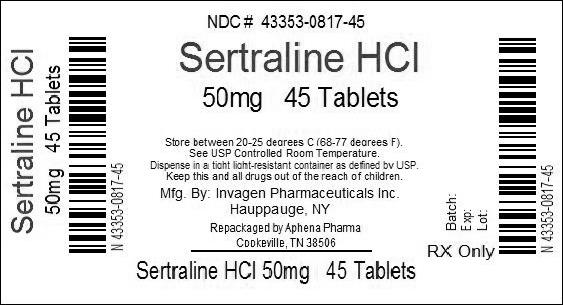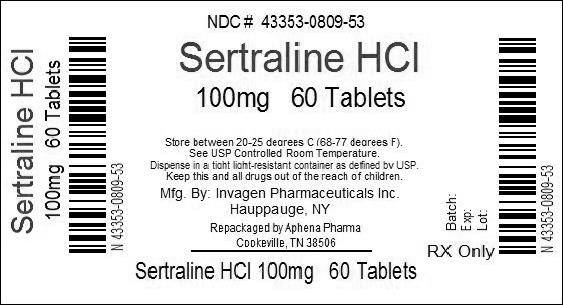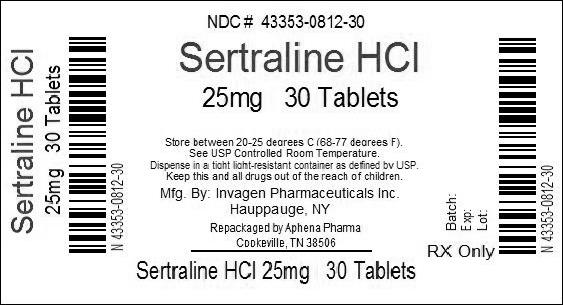For most of the drugs advantages of taking medications overweighs the potential risks however some drugs could be really dangerous for breastfed baby hence every medication shall be considered separately. In this page we will discuss about purpose of Sertraline Tablet and its risk associated with lactation. We will also discuss the usage of Sertraline Tablet and some common side effects associated with Sertraline Tablet.
What is Sertraline Tablet used for?
Major Depressive Disorder Sertraline is indicated for the treatment of major depressive disorder in adults. The efficacy of sertraline in the treatment of a major depressive episode was established in six to eight week controlled trials of adult outpatients whose diagnoses corresponded most closely to the DSM-III category of major depressive disorder (see Clinical Trials under CLINICAL PHARMACOLOGY). A major depressive episode implies a prominent and relatively persistent depressed or dysphoric mood that usually interferes with daily functioning (nearly every day for at least 2 weeks); it should include at least 4 of the following 8 symptoms: change in appetite, change in sleep, psychomotor agitation or retardation, loss of interest in usual activities or decrease in sexual drive, increased fatigue, feelings of guilt or worthlessness, slowed thinking or impaired concentration, and a suicide attempt or suicidal ideation. The antidepressant action of sertraline in hospitalized depressed patients has not been adequately studied. The efficacy of sertraline in maintaining an antidepressant response for up to 44 weeks following 8 weeks of open-label acute treatment (52 weeks total) was demonstrated in a placebo-controlled trial. The usefulness of the drug in patients receiving sertraline for extended periods should be reevaluated periodically (see Clinical Trials under CLINICAL PHARMACOLOGY). Obsessive-Compulsive Disorder Sertraline is indicated for the treatment of obsessions and compulsions in patients with obsessive-compulsive disorder (OCD), as defined in the DSM-III-R; i.e., the obsessions or compulsions cause marked distress, are time-consuming, or significantly interfere with social or occupational functioning. The efficacy of sertraline was established in 12-week trials with obsessive-compulsive outpatients having diagnoses of obsessive-compulsive disorder as defined according to DSM-III or DSM-III-R criteria (seeClinical Trials under CLINICAL PHARMACOLOGY). Obsessive-compulsive disorder is characterized by recurrent and persistent ideas, thoughts, impulses, or images (obsessions) that are ego-dystonic and/or repetitive, purposeful, and intentional behaviors (compulsions) that are recognized by the person as excessive or unreasonable. The efficacy of sertraline in maintaining a response, in patients with OCD who responded during a 52-week treatment phase while taking sertraline and were then observed for relapse during a period of up to 28 weeks, was demonstrated in a placebo-controlled trial (see Clinical Trials under CLINICAL PHARMACOLOGY). Nevertheless, the physician who elects to use sertraline for extended periods should periodically re-evaluate the long-term usefulness of the drug for the individual patient (see DOSAGE AND ADMINISTRATION). Panic Disorder Sertraline is indicated for the treatment of panic disorder in adults, with or without agoraphobia, as defined in DSM-IV. Panic disorder is characterized by the occurrence of unexpected panic attacks and associated concern about having additional attacks, worry about the implications or consequences of the attacks, and/or a significant change in behavior related to the attacks. The efficacy of sertraline was established in three 10–12 week trials in adult panic disorder patients whose diagnoses corresponded to the DSM-III-R category of panic disorder (see Clinical Trials under CLINICAL PHARMACOLOGY). Panic disorder (DSM-IV) is characterized by recurrent unexpected panic attacks, i.e., a discrete period of intense fear or discomfort in which four (or more) of the following symptoms develop abruptly and reach a peak within 10 minutes: (1) palpitations, pounding heart, or accelerated heart rate; (2) sweating; (3) trembling or shaking; (4) sensations of shortness of breath or smothering; (5) feeling of choking; (6) chest pain or discomfort; (7) nausea or abdominal distress; (8) feeling dizzy, unsteady, lightheaded, or faint; (9) derealization (feelings of unreality) or depersonalization (being detached from oneself); (10) fear of losing control; (11) fear of dying; (12) paresthesias (numbness or tingling sensations); (13) chills or hot flushes. The efficacy of sertraline in maintaining a response, in adult patients with panic disorder who responded during a 52-week treatment phase while taking sertraline and were then observed for relapse during a period of up to 28 weeks, was demonstrated in a placebo-controlled trial (see Clinical Trials under CLINICAL PHARMACOLOGY). Nevertheless, the physician who elects to use sertraline for extended periods should periodically re-evaluate the long-term usefulness of the drug for the individual patient (see DOSAGE AND ADMINISTRATION). Posttraumatic Stress Disorder (PTSD) Sertraline is indicated for the treatment of posttraumatic stress disorder in adults. The efficacy of sertraline in the treatment of PTSD was established in two 12-week placebo-controlled trials of adult outpatients whose diagnosis met criteria for the DSM-III-R category of PTSD (see Clinical Trials under CLINICAL PHARMACOLOGY). PTSD, as defined by DSM-III-R/IV, requires exposure to a traumatic event that involved actual or threatened death or serious injury, or threat to the physical integrity of self or others, and a response which involves intense fear, helplessness, or horror. Symptoms that occur as a result of exposure to the traumatic event include reexperiencing of the event in the form of intrusive thoughts, flashbacks or dreams, and intense psychological distress and physiological reactivity on exposure to cues to the event; avoidance of situations reminiscent of the traumatic event, inability to recall details of the event, and/or numbing of general responsiveness manifested as diminished interest in significant activities, estrangement from others, restricted range of affect, or sense of foreshortened future; and symptoms of autonomic arousal including hypervigilance, exaggerated startle response, sleep disturbance, impaired concentration, and irritability or outbursts of anger. A PTSD diagnosis requires that the symptoms are present for at least a month and that they cause clinically significant distress or impairment in social, occupational, or other important areas of functioning. The efficacy of sertraline in maintaining a response in adult patients with PTSD for up to 28 weeks following 24 weeks of open-label treatment was demonstrated in a placebo-controlled trial. Nevertheless, the physician who elects to use sertraline for extended periods should periodically re-evaluate the long-term usefulness of the drug for the individual patient (see DOSAGE AND ADMINISTRATION). Premenstrual Dysphoric Disorder (PMDD) sertraline is indicated for the treatment of premenstrual dysphoric disorder (PMDD) in adults. The efficacy of sertraline in the treatment of PMDD was established in 2 placebo-controlled trials of female adult outpatients treated for 3 menstrual cycles who met criteria for the DSM-III-R/IV category of PMDD (see Clinical Trials under CLINICAL PHARMACOLOGY). The essential features of PMDD include markedly depressed mood, anxiety or tension, affective lability, and persistent anger or irritability. Other features include decreased interest in activities, difficulty concentrating, lack of energy, change in appetite or sleep, and feeling out of control. Physical symptoms associated with PMDD include breast tenderness, headache, joint and muscle pain, bloating and weight gain. These symptoms occur regularly during the luteal phase and remit within a few days following onset of menses; the disturbance markedly interferes with work or school or with usual social activities and relationships with others. In making the diagnosis, care should be taken to rule out other cyclical mood disorders that may be exacerbated by treatment with an antidepressant. The effectiveness of sertraline in long-term use, that is, for more than 3 menstrual cycles, has not been systematically evaluated in controlled trials. Therefore, the physician who elects to use sertraline for extended periods should periodically re-evaluate the long-term usefulness of the drug for the individual patient (see DOSAGE AND ADMINISTRATION). Social Anxiety Disorder Sertraline is indicated for the treatment of social anxiety disorder, also known as social phobia in adults. The efficacy of sertraline in the treatment of social anxiety disorder was established in two placebo-controlled trials of adult outpatients with a diagnosis of social anxiety disorder as defined by DSM-IV criteria (see Clinical Trials under CLINICAL PHARMACOLOGY). Social anxiety disorder, as defined by DSM-IV, is characterized by marked and persistent fear of social or performance situations involving exposure to unfamiliar people or possible scrutiny by others and by fears of acting in a humiliating or embarrassing way. Exposure to the feared social situation almost always provokes anxiety and feared social or performance situations are avoided or else are endured with intense anxiety or distress. In addition, patients recognize that the fear is excessive or unreasonable and the avoidance and anticipatory anxiety of the feared situation is associated with functional impairment or marked distress. The efficacy of sertraline in maintaining a response in adult patients with social anxiety disorder for up to 24 weeks following 20 weeks of sertraline treatment was demonstrated in a placebo-controlled trial. Physicians who prescribe sertraline for extended periods should periodically re-evaluate the long-term usefulness of the drug for the individual patient (see Clinical Trials under CLINICAL PHARMACOLOGY).
Is Sertraline Tablet usage safe while breastfeeding? If a lactating mother is using it can there be any effect on growth or development of infant?
Active ingredient in Sertraline Tablet is Sertraline and based on our analysis of Sertraline it appears that using Sertraline Tablet is safe in breastfeeding. Below is analysis of Sertraline while breastfeeding.
Statement of Manufacturer/Labeler about breastfeeding usage
Nursing Mothers It is not known whether, and if so in what amount, sertraline or its metabolites are excreted in human milk. Because many drugs are excreted in human milk, caution should be exercised when sertraline is administered to a nursing woman.
Sertraline Tablet Breastfeeding Analsys
SafeCAS Number: 79559-97-0
Excreted in tiny amounts into breast milk. Serum levels of breastfed infants whose mothers are on Sertraline are usually undetectable or very low. No harm effect has been observed on health and short or long term development of infants. Transient troubles in the early neonatal period like drug withdrawal syndrome among newborn or premature infants with high serum levels as a result of treatment with Sertraline to the mother during pregnancy have been observed. Sertraline causes fewer problems related to galactorrhea than other antidepressant drugs. It is probably the safest antidepressant medication while breastfeeding. Mothers who are treated with antidepressant medicaction are in need of stronger support for a higher risk of early breastfeeding failure.
Sertraline Tablet Breastfeeding Analsys - 2
CAS Number: 79617-96-2

Because of the low levels of sertraline in breastmilk, amounts ingested by the infant are small and is usually not detected in the serum of the infant, although the weakly active metabolite norsertraline (desmethylsertraline) is often detectable in low levels in infant serum. Rarely, preterm infants with impaired metabolic activity might accumulate the drug and demonstrate symptoms similar to neonatal abstinence. Most authoritative reviewers consider sertraline a preferred antidepressants during breastfeeding.[1][2][3][4][5][6][7] Mothers taking an SSRI during pregnancy and postpartum may have more difficulty breastfeeding, although this might be a reflection of their disease state.[8] These mothers may need additional breastfeeding support. Breastfed infants exposed to an SSRI during the third trimester of pregnancy have a lower risk of poor neonatal adaptation than formula-fed infants.

What should I do if I am breastfeeding mother and I am already exposed to Sertraline Tablet?
As usage of Sertraline Tablet is mostly safe while breastfeeding hence there should not be any concern. In case of any change in behavior or health of your baby you should inform your health care provider about usage of Sertraline Tablet else no further action is required.
I am nursing mother and my doctor has suggested me to use Sertraline Tablet, is it safe?
Definitely, Sertraline Tablet is safe in lactation for baby. No wonder your doctor has recommended it.
If I am using Sertraline Tablet, will my baby need extra monitoring?
No extra baby monitoring required while mother is using Sertraline Tablet
Who can I talk to if I have questions about usage of Sertraline Tablet in breastfeeding?
US
National Womens Health and Breastfeeding Helpline: 800-994-9662 (TDD 888-220-5446) 9 a.m. and 6 p.m. ET, Monday through Friday
UK
National Breastfeeding Helpline: 0300-100-0212 9.30am to 9.30pm, daily
Association of Breastfeeding Mothers: 0300-330-5453
La Leche League: 0345-120-2918
The Breastfeeding Network supporter line in Bengali and Sylheti: 0300-456-2421
National Childbirth Trust (NCT): 0300-330-0700
Australia
National Breastfeeding Helpline: 1800-686-268 24 hours a day, 7 days a week
Canada
Telehealth Ontario for breastfeeding: 1-866-797-0000 24 hours a day, 7 days a week




